|
|
|
| Mon Nov 5, 2007 - 11:17 AM EST - By Harv Laser | |
|
|
|
|
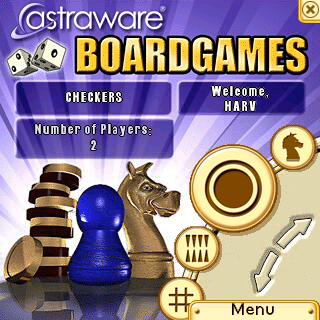
When I think of classic board games, images of Monopoly, Clue, Sorry!, The Game of Life, Scrabble, and many others I kept in those huge cardboard boxes on shelves and under the bed when I was much younger. Those spring to mind, right alongside the ever-popular favorites: chess and checkers.
So, when sampling Astraware�s new Classic Board Games ("CGB") I was surprised to see a few titles that were a complete mystery to me. This probably has something to do with the fact that Astraware is a British software house.
But true to the word, "classical" takes on a precise meaning when you consider the actual ancestry of the games in this package, some of which date back thousands of years to ancient Egypt and Mesopotamia.
Naturally, like all Astraware titles, CBG is stunningly beautiful, with top-notch, crisp and vivid arcade style, neo-realistic graphics side-by-side with the life-like sounds of moving pieces and rattling dice cups. Astraware's coders REALLY know their stuff.
Top it off with the stereotypical Astraware application�s ability to run from an SD card, requiring internal memory only when loaded, and to save your game progress (in all eight games) for later so that you may always exit and return to your game exactly where you left off.
Additionally, like most of Astraware�s titles, you can download a free trial version and play with it for quite a while, before you lay down your cash for a key code, though each time you load an unregistered copy a nag box asking you to buy it takes longer and longer to go away.
To be clear, all eight games in this package come in ONE .prc file and are launched from ONE master screen pictured above. Just use the curved arrows to highlight, and then select the game of your choice.
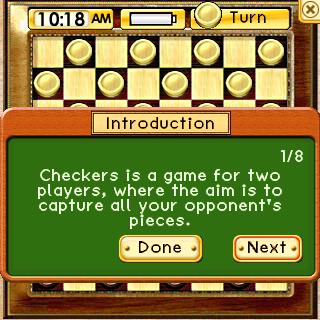
Certainly, if you�ve played any board game in your life, you�ve played Checkers; but did you know that Checkers, called "Draughts" in the rest of the world, is a nearly 3,500 year-old concept? That�s right: as far back as ancient Egypt people have been playing a game named Alquerque, which is the ancient ancestor of the modern Checkers game.
As a kid, I remember playing checkers with little wooden discs that came in a small red and tan box on a solid wooden board. Now it�s unlikely that anybody sells a set made of anything other than plastic and cardboard, though nothing's changed about how the game plays, only how it looks.
Astraware recreates the experience of a traditional English style (8x8 square) checkerboard, complete with wood grain in pine and mahogany. The game play is fluid and straightforward, and you may optionally enable multiple huffing modes along with a complete set of difficulty preferences. As with all of the games in CBG, you can select to set a global difficulty level, or define it on a per-game basis, which I recommend.
In any case, the default �Easy� setting still makes for a competitive checkers game, while the �Medium� or �Hard� levels are increasingly taxing. In fact, I�ve yet to beat the computer in either of the latter settings, so don�t take the �Medium� setting in any game lightly, as the AI algorithms can be quite intuitive in its selection of moves.
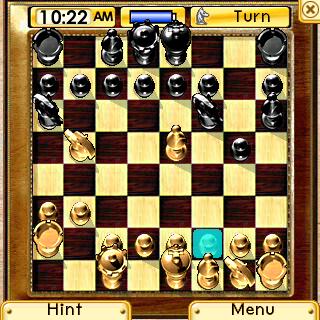
Many people consider chess to be the noblest of all games: a willful method of expanding one's intellect and exploring various stratagems until the cows come home.
During the Middle Ages, chess was the game of Lords and soldiers, for both teaching mental discipline, and for offering a challenging way of wagering on your skill, without risking your neck. Both of these concepts still apply in the modern world, where chess clubs such as the US Chess Federation offer local and global competitions for prestige, along with suitably large sums of money. In fact, books on chess strategy are the most widely published for any game, some of which date back to the 13 th century.
You don�t have to be a chess expert or grandmaster to enjoy the CBG rendition, as it offers you plenty of advice if you are a novice, yet it's challenging enough for a seasoned player via its toggle-able difficulty settings. The game also highlights valid moves, and understands both �castling� and �en passant� moves, so there are no restrictions on proper play.
Above all else, the game itself is beautiful eye candy, with large, easy to see traditional pieces in maple and ebony, though it lacks the rank and file numbering (for notation) seen on league boards, which I think would make a nice option. All in all, sitting back with Treo in hand, the game brings up visions of sitting in a London club with a pipe of strong Latakia and a snifter of brandy, playing against the local gentry, and conversing about the weather or political affairs. Or, perhaps not.
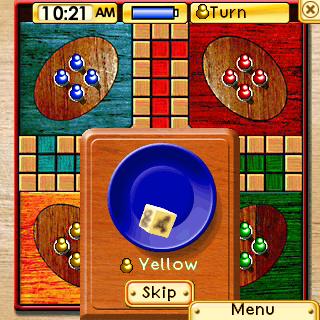
I was totally unaware of the existence of Ludo before playing it in Astraware�s game pack. Although it resembles the classical Parcheesi, it has some differences. Essentially, both games spring from the same ancestry, as they are both based on the classical �Royal Game of India: Pachisi�, though Ludo is more commonplace in England than it is here in the States.
The goal, in any event, is to roll dice to promote your pawns out of their nest. In order to do so, you have to roll a specific number, which you may choose in the vast prefs pane for this game, and then continue to roll a die as you move your pieces along the board until you get all four of your color to your home square.
Sure, it sounds simple, but the versatility of the rules, which includes options for blocking, breakouts and other �home rules� makes for a game that involves both strategy as well a great deal of luck. Realistically, Ludo is a game that you really want to play with your friends when sitting at a bar rather than against the computer, as if you elect to do the latter you�ll be spending at least three-fourths of the time watching a tiny pearl-colored die roll in a blue cup.
Speaking of which, the animations and graphics are especially superb here, with a differently colored (stained) wood-grain board and plastic-y looking pieces. The animation of the dice-cup is very fast, though you may get tired of it eventually, in which case you can simply turn it off as a preference setting.
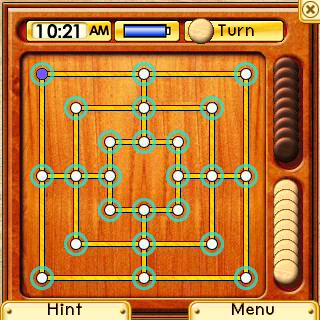
Here is another game that I�ve never played before, though it�s similar to several games that I remember my cousins playing as a child. Its origins are of extreme antiquity, as is its name, for the ancient Romans played the game and even permanently carved it into fixtures in their homes, though the version they played was usually a twelve piece edition with additional (diagonal) lines.
This game was far more popular in ages past, than it is today, and even William Shakespeare writes in �A Midsummer Night�s Dream� that �The nine-men�s Morris is filled up with mud.� In fact, Morris exists in three, six, nine and twelve piece versions, though people only commonly play the nine and twelve �men's� style these days.
So.. if you're like me and have never had the chance to play this intriguing, challenging game, Astraware�s version is a breath of fresh air that offers up a completely new, classical environment in which you can test your skills either against your pals or against the flexible computer opponents.
The ultimate object of the game is to set up your �men�, who you later mobilize into strings of three pieces called Mills. Once you form a mill, you may remove one of your opponent�s pieces, with the ultimate goal of stripping your challenger down to only two men. This is nowhere nearly as easy as it seems, especially against the computer, which is sharp enough win, even in �Easy� mode against an inexperienced player.
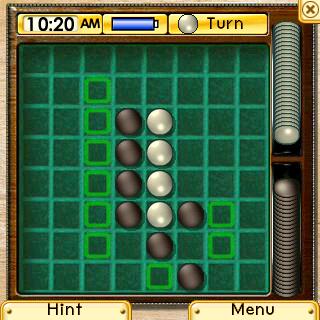
Traditional Reversi is the invention of Lewis Waterman and John W. Mollet, circa 1880 in England, although modern Reversi is somewhat different, as it bases its rules on those of the game Othello, developed 90 years later in Mito, Ibaraki, Japan.
Either way, though, it is a fun, but complex game to master, and the object is simple: you must place your pieces on the board in order to capture those of your opponent. You do so by surrounding discs of the opposing color, thus changing them into your color from white to black or visa versa, much like the Japanese game Go.
The edition included in the CBG pack uses the Othello rules, with four pieces starting off in the middle of the board. Like all of the other games in this beautiful suite, the graphics are spectacular, though this time wood grain gives way to a soft green, almost grassy, �Zen� playing field with pieces that look like sugar and licorice drops. The play experience is much closer to one of Japanese culture than that of European, which gives the game a refreshing air difference from the others in the package.
Game play itself is relaxing, with slick animations of the pieces flipping over, dancing to a simultaneous, satisfying �click� of their rotation. If you want a true challenge in this game, however, you�ll need to set it on at least �Medium�, as I found the AI less strategic in �easy� mode than in the other games.
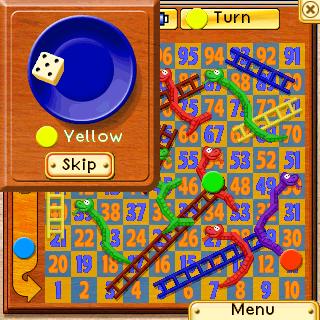
�Snakes and Ladders� is another common English game that, when imported into the Colonies, had a name change and a facelift. The game originated in Victorian England where it was commonly a parlor game, played by the denizens alongside other commonalities of the era. Over on this side of the pond, we�re used to the game marketed as �Chutes and Ladders�, sold primarily to parents for their children.
The basic idea is to progress your pawn from the start to the finish, either by escalating though each square individually, or you can get lucky and land on a ladder (to skip some rows) or unlucky by landing on a snake, which shunts you backward. The only way to win is by pure luck, as no decision making process takes place between turns, so this is an ideal game to play with your kids, or less intellectual bar friends, who've downed a few too many pints.
This time the gaming surface looks like an out-of-the-box cardboard and plastic children�s game, which is precisely what you�d expect, and a nice change of pace.
The game places its elements (snakes & ladders) randomly, adding to the luck factor, and they have remarkable detail to them, including little eyes and forked (!) tongues on the teensy plastic reptiles. This time, pawns take the form of brightly colored discs, also with a (less drastic) three dimensional appearance.
The dice cup makes its second appearance here, though it is unchanged from Ludo, and if you wish you may suspend it in S&L as well, along with the other, general plethora of preference & difficulty settings, the latter of which seems mostly to just affect the outcome of your die rolls.
Unique settings to this game allow you to dictate the size of the board, along with the number (and length) of the snakes and ladders, providing an exceptionally diverse experience to an otherwise simple game.
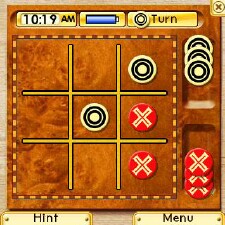
At some time in your life, I�m gonna bet that you�ve played Tic-Tac-Toe. It�s the ultimate childhood game of naughts and crosses you used to play in the sand with your schoolyard chums, or on pencil and paper with your dad. Though the Astraware version doesn�t add any complexity or depth to the game, it does make it simply gorgeous with a vividly detailed, stained and painted playing board and disc-like playing pieces that appear to be carved and painted.
Unfortunately, this is the ultimate time-waster, as if you leave it set to �Easy�, you�ll win every game, or if you set it to �Medium�, you�ll likely just end each game in a draw.
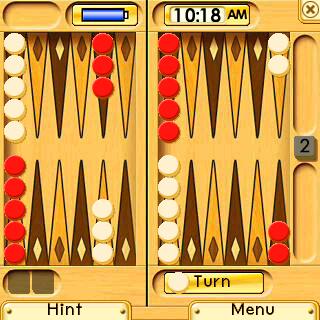
The final element to the CBG pack is the noble game of luck and strategy, backgammon: the only game in this lot for people to regularly play in a casino format. It�s also a game with a rich history, setting its roots in ancient Egypt and Mesopotamia in the games of Senet and what archaeologists have dubbed the Royal Game of Ur.
As a casino game, in a way it largely resembles poker, as it is played in both live (cash) and tournament formats, in which you opt to play for a set amount of money per point, and may offer to raise the stakes during the game or attempt to back out before losing all your cabbage. In fact, Dan Harrington, one of the best poker players in the world is also a championship Backgammon player.
If you�ve never played the game before, it does take some steep adjusting to get used to the concepts, and though (like chess) there are many books covering strategies, part of the game is simple luck, the throw of the dice, as it were. For this reason, I�ve found that the built in �Hint� button (found in all eight games in CBG).. is exceptionally useful, as it usually points out overlooked, game saving moves.
Astraware's Backgammon covers all of the aspects of a complete, casino style game, including the �Doubling Cube�, which is essential to money play, all of which employ the classic look and feel of a wooden, folding backgammon set, complete with hinge lines. The dice cup is back again, but this time it rotates between tossing two white and two red dice, illustrating who is �up at bat�.
The only downside to the game is that, unlike all of the other games in this package, Backgammon is stylus heavy. In fact, I�d say it is stylus-essential, as it�s far too easy to make a huge, blundering error with your fingertip that can cost you an entire game and tons of points, especially if you are playing against a real person for money.
Copyright 1999-2016 TreoCentral. All rights reserved :
Terms of Use : Privacy Policy
TREO and TreoCentral are trademarks or registered trademarks of palm, Inc. in the United States and other countries;
the TreoCentral mark and domain name are used under license from palm, Inc.
The views expressed on this website are solely those of the proprietor, or
contributors to the site, and do not necessarily reflect the views of palm, Inc.
Read Merciful by Casey Adolfsson